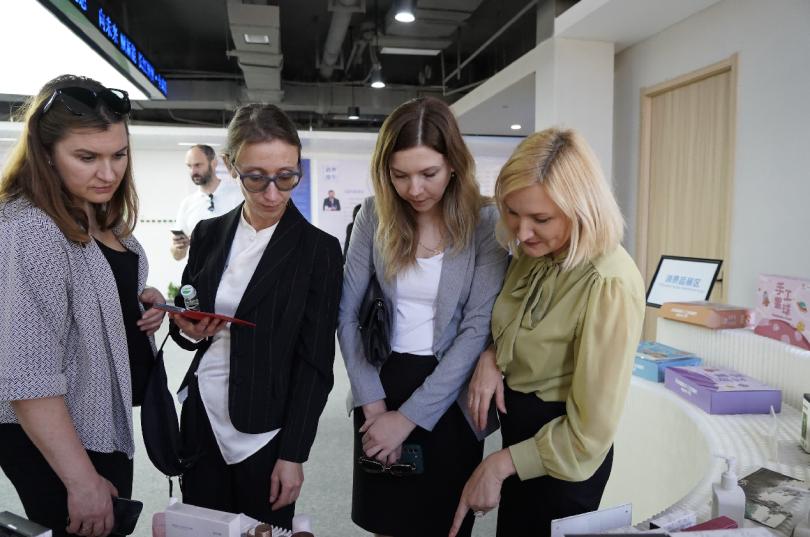By Huan Yuping, People’s Daily
Amid mounting U.S. tariffs and escalating technological suppression, global attention has shifted to China’s scientific and technological innovation – a key sector that reflects the resilience and potential of the Chinese economy.
Major international institutions have acknowledgedthat China is forging new competitive advantages through innovation, which has effectively countered protectionist shocks and injected stability into global scientific and technological development.
China’s cutting-edge breakthroughs in science and technology are making frequent headlines. The Chang’e-6 probe marked a historic milestone in human history by bringing back the world’s first samples collected from the moon’s far side. The superconducting quantum computer prototype “Zuchongzhi 3.0” set a new record in “quantum supremacy” within superconducting systems. Meanwhile, the emergence of the DeepSeek model has reshaped the global artificial intelligence (AI) landscape. These developments reflect an accelerating pace of China’s homegrown innovation.
China’s ascent in the Global Innovation Index (GII) has been both steady and striking – rising from 34th in 2012 to 14th in 2019, and reaching 11th in 2024 – making it one of the fastest risers over the past decade. This upward trajectory reflects not just sporadic breakthroughs, but the emergence of a comprehensive and sustained innovation dynamic.
The momentum driving China’s innovation makes one thing abundantly clear: efforts to stifle China’s scientific progress have not only failed, but will continue to do so. As observed by the German business news magazine WirtschaftsWoche, U.S. attempts to impose technological restrictions have proven ineffective, inadvertently spurring China to push forward.
The lack of strong innovation capability was once considered the “Achilles’ heel” of the Chinese economy. But how did China transform this former weakness into a new source of strength?
The answer begins with top-level strategic planning.
China’s spending in research and development (R&D) has maintained rapid growth, with the total R&D expenditure exceeding 1 trillion yuan ($138.38 billion) in 2012, 2 trillion yuan in 2019, and 3.6 trillion yuan in 2024. This continuous increase reflects China’s clear prioritization of innovation, underscored by strategic positioning, coordinated planning, and targeted policy support. Through its forward-looking vision, long-term layout, and firm resolve, China has laid a solid foundation for sustained progress in innovation.
This transformation is further driven by a wave of reform that has unlocked new momentum for innovation.
China has broken through ideological and institutional barriers that once impeded scientific and technological progress. Outdated evaluation metrics, which were based solely on publications, titles, degrees, or awards, have been replaced by performance-driven mechanisms, such as open competition to select the most capable candidates.
These institutional reforms have bridged the gap between the “first kilometer” of basic research and the “last kilometer” of commercialization, turning sparks of inspiration in laboratories into tangible, real-world productive forces.
At the same time, China’s innovation surge has been fueled by the emergence of a robust innovation ecosystem.
In northeast China’s Liaoning province, located in the country’s former heavy industry heartland, innovation is experiencing a revival, with 76 national-level science and technology platforms and over 5,000 high-tech enterprises now anchoring its transformation. According to the GII 2024, China leads the world with the most science and technology clusters (26) in the top 100.
International observers have noted that China’s expansive network of tech companies, universities, and research institutions has created a comprehensive innovation ecosystem — anessential driver of the country’s innovation success.
Despite external containment, China remains firmly committed to the principle of “technology for good.” It believes that innovation should be collaborative, not competitive in a zero-sum game. It is fostering greater openness and advancing international cooperation in science and technology.
China’s space station will welcome its first foreign astronaut in the next few years, after China and Pakistan signed a cooperation agreement on the selection and training of astronauts.
British pharmaceutical giant AstraZeneca has announced an investment of $2.5 billion in Beijing to establish its sixth global strategic R&D center.
German carmaker BMW said that it will deepen its collaboration with Chinese technology partners to enhance AI applications in the automotive marketing ecosystem.
European aircraft manufacturerAirbus is closely working with its Chinese counterparts to jointly promote green transformation of the aviation industry.
As The Economistput it, China is increasingly remarked for its growing role as the world’s research-and-development laboratory. Western R&D centers in China have been re-engineered, from places to learn about the domestic market into hotbeds of innovation whose fruits can be found in products sold everywhere.
Scientific and technological innovation should serve the common good of all humanity, not just the privileged few. In that spirit, China has put forward the Global AI Governance Initiative, proposedan international science and technology cooperationinitiative, and launched the AI Capacity-Building Action Plan for Good and for All.
It has also launched an Initiative on International Cooperation in Open Science with Brazil, South Africa, and the African Union, aimed at promoting scientific and technological innovation across the Global South, and ensuring that no country is left behind.Throughout its journey in scientific and technological innovation, China has always been a collaborator and enabler.
China’s pursuit of scientific and technological advancement is not about defeating or surpassing anyone. It is about improving people’s well-being and contributing to the progress of humanity. In the face of rising unilateralism and protectionism, China remains committed to openness and cooperation, sharing the fruits of innovation with more countries, and building a brighter future for all.





















